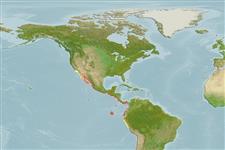Common names from other countries
>
Eupercaria/misc (Various families in series Eupercaria) >
Lutjanidae (Snappers) > Lutjaninae
Etymology: Lutjanus: Malay, ikan lutjan, name of a fish.
More on author: Peters.
Environment: milieu / climate zone / depth range / distribution range
экология
морской; солоноватоводный ассоциированный с рифами; пределы глубины 3 - 60 m (Ref. 9313). Subtropical; 36°N - 13°S, 120°W - 77°W (Ref. 55)
Eastern Pacific: southern California to Peru, rare north of Baja California, Mexico; also at the Cocos and Galapagos islands.
Length at first maturity / Size / Вес / Возраст
Maturity: Lm 19.5, range 19 - 20 cm
Max length : 71.0 cm TL самец/пол неопределен; (Ref. 40637); наибольший вес (опубликованные данные): 13.0 kg (Ref. 40637)
Краткое описание
определительные ключи | морфология | морфометрия
колючие лучи спинного плавника (общее число) : 10; членистые (мягкие) лучи спинного плавника (общее число) : 14; колючие лучи анального плавника: 3; членистые (мягкие) лучи анального плавника: 8. Forehead slopes steeply; snout somewhat pointed. Preopercular notch and knob weak. Scale rows on back parallel with lateral line. Rosy red anteriorly, becoming bright orange to yellow over most of the body; the fins are mainly yellow or orange; the inside of the mouth is white; a bluish horizontal streak runs below the eye.
Found in inshore reef areas over hard bottoms until at least 60 m depth (Ref. 9313). Tolerant to freshwaters (Ref. 36880). Form aggregations during daylight and shelter as solitary fish in caverns. Feed on fishes, shrimps, crabs and mollusks. Marketed fresh or frozen (Ref. 9313).
Allen, G.R., 1985. FAO Species Catalogue. Vol. 6. Snappers of the world. An annotated and illustrated catalogue of lutjanid species known to date. FAO Fish. Synop. 125(6):208 p. Rome: FAO. (Ref. 55)
Статус Красного Списка МСОП (Ref. 130435)
CITES (Ref. 128078)
Not Evaluated
Угроза для людей
Harmless
Использование человеком
рыболовство: коммерческий; аквакультура (рыбоводство): экспериментальный
дополнительная информация
инструменты
Специальные отчеты
Скачать в формате XML
ресурсы в Интернет
Estimates based on models
Preferred temperature (Ref.
115969): 20.5 - 28.6, mean 25.8 (based on 84 cells).
Phylogenetic diversity index (Ref.
82804): PD
50 = 0.5000 [Uniqueness, from 0.5 = low to 2.0 = high].
Bayesian length-weight: a=0.01479 (0.01296 - 0.01687), b=2.97 (2.94 - 3.00), in cm Total Length, based on LWR estimates for this species (Ref.
93245).
Trophic level (Ref.
69278): 4.0 ±0.63 se; based on food items.
устойчивость к внешним воздействиям (Ref.
120179): низкий, минимальное время удвоения популяции 4.5-14 лет (K=0.15;).
Fishing Vulnerability (Ref.
59153): High vulnerability (56 of 100).
Climate Vulnerability (Ref.
125649): Very high vulnerability (80 of 100).
